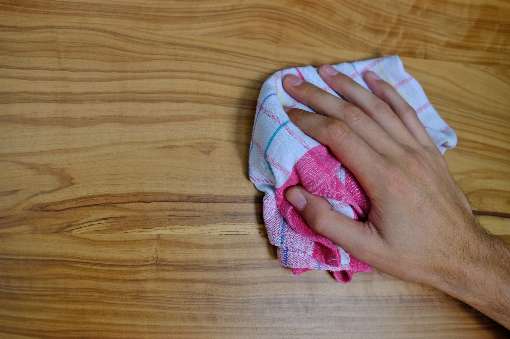17.07.2019
Just like thick solid wood, veneer surfaces are basically either sealed or open grain. Slight dirt on open grain veneer surfaces can be removed easily with a soft cloth. Here it is important to note: the cloth should be dry and above all clean. Otherwise the surface could be affected negatively. Do not use microfibre cloths, as they can scratch the surface. Milky liquid polishes are allowed; however, they must be applied thinly with a dust cloth.
A damp cloth can be used to clean sealed veneer surfaces. Here it must be noted that damp means lightly moistened and not soaking wet! Highly soiled areas must be rubbed very carefully with the slightly damp cloth. Then wipe the area dry immediately, without pressure, using a soft cloth. Fast action is needed in particular in case of coffee, tea, alcohol and fruit stains to prevent lasting unattractive traces. In case of acidic liquids, the cleaned area should then be wiped using a damp chamois leather. Varnished veneer surfaces may also not be cleaned with microfibre cloths, as their fine fibres can damage the veneered surface. “Milk”-based furniture polishes should be used sparingly; however, when used on varnished surfaces they restore perfect gloss. On the other hand, bleaching additives (e.g. lemon) as well as all other cleaning agents, polishing powders and abrasives are fully unsuitable for cleaning veneer surfaces.
Veneer surfaces can be repaired effectively
Minor scratches and stria in the veneer surface are completely normal signs of wear and tear. If you nonetheless want to remove them, they can be filled with hard wax in the same wood colour, rubbed down flat and then coated with a suitable varnish or stain. Detached veneer can be glued back on with wood glue. IFN/RK
Initiative Furnier + Natur (IFN)
Initiative Furnier + Natur (IFN) e.V. was founded in 1996 by the German veneer industry and its partners. The purpose of the association based in Bad Honnef is to promote veneer as a material. It is funded and supported by European companies in the veneer industry, trade and the veneer processing industry as well as professional associations of the timber industry.
Image: With a little bit of occasional care, veneer surfaces stay fine and attractive permanently. Photo: IFN
Downloads
2019-07-17_PM-2019-IFN-Pflege-von-Furnieroberflaechen.jpg (1.15 MB)
Wood veneer care tips: How to keep veneer surfaces fine and attractive
Bad Honnef. Furniture with fine veneer surfaces made of real wood is truly delightful. The veneered surfaces require occasional care to maintain their attractive appearance in the longterm. In general, furniture is finished with surface protection to protect it against dirt. When the time comes to clean them, there are several things that have to be borne in mind so that the attractive wood veneer surfaces do not become damaged, advises Initiative Furnier + Natur e. V. (IFN).Just like thick solid wood, veneer surfaces are basically either sealed or open grain. Slight dirt on open grain veneer surfaces can be removed easily with a soft cloth. Here it is important to note: the cloth should be dry and above all clean. Otherwise the surface could be affected negatively. Do not use microfibre cloths, as they can scratch the surface. Milky liquid polishes are allowed; however, they must be applied thinly with a dust cloth.
A damp cloth can be used to clean sealed veneer surfaces. Here it must be noted that damp means lightly moistened and not soaking wet! Highly soiled areas must be rubbed very carefully with the slightly damp cloth. Then wipe the area dry immediately, without pressure, using a soft cloth. Fast action is needed in particular in case of coffee, tea, alcohol and fruit stains to prevent lasting unattractive traces. In case of acidic liquids, the cleaned area should then be wiped using a damp chamois leather. Varnished veneer surfaces may also not be cleaned with microfibre cloths, as their fine fibres can damage the veneered surface. “Milk”-based furniture polishes should be used sparingly; however, when used on varnished surfaces they restore perfect gloss. On the other hand, bleaching additives (e.g. lemon) as well as all other cleaning agents, polishing powders and abrasives are fully unsuitable for cleaning veneer surfaces.
Veneer surfaces can be repaired effectively
Minor scratches and stria in the veneer surface are completely normal signs of wear and tear. If you nonetheless want to remove them, they can be filled with hard wax in the same wood colour, rubbed down flat and then coated with a suitable varnish or stain. Detached veneer can be glued back on with wood glue. IFN/RK
Initiative Furnier + Natur (IFN)
Initiative Furnier + Natur (IFN) e.V. was founded in 1996 by the German veneer industry and its partners. The purpose of the association based in Bad Honnef is to promote veneer as a material. It is funded and supported by European companies in the veneer industry, trade and the veneer processing industry as well as professional associations of the timber industry.
Image: With a little bit of occasional care, veneer surfaces stay fine and attractive permanently. Photo: IFN
Downloads
2019-07-17_PM-2019-IFN-Pflege-von-Furnieroberflaechen.jpg (1.15 MB)
